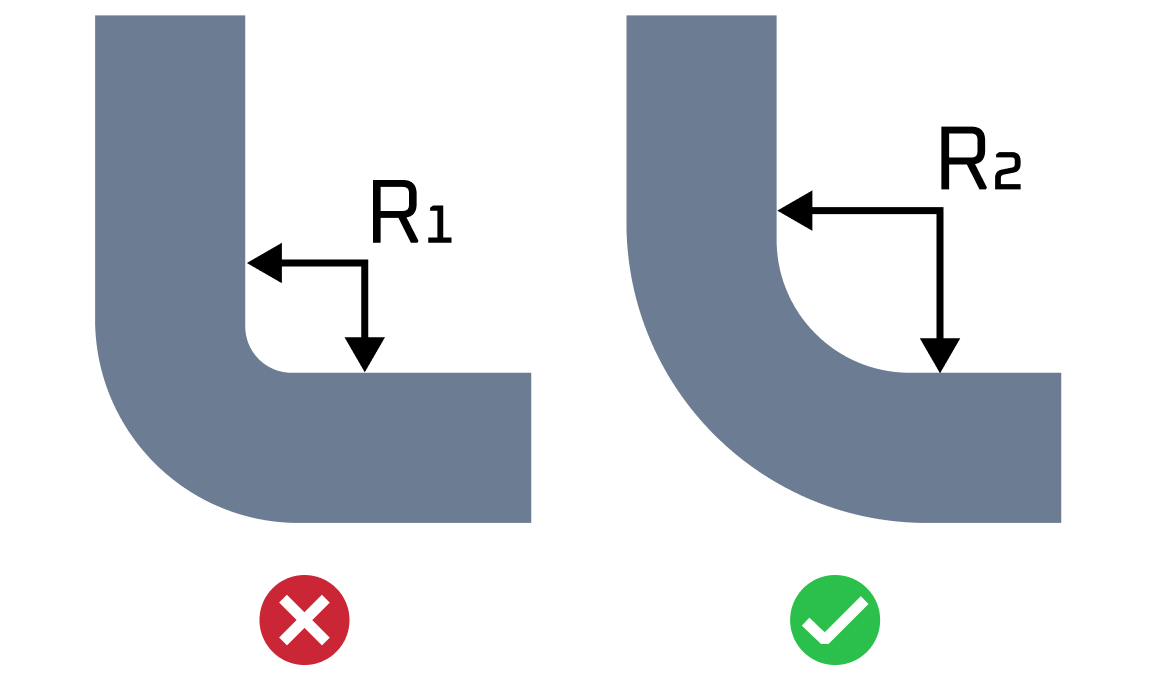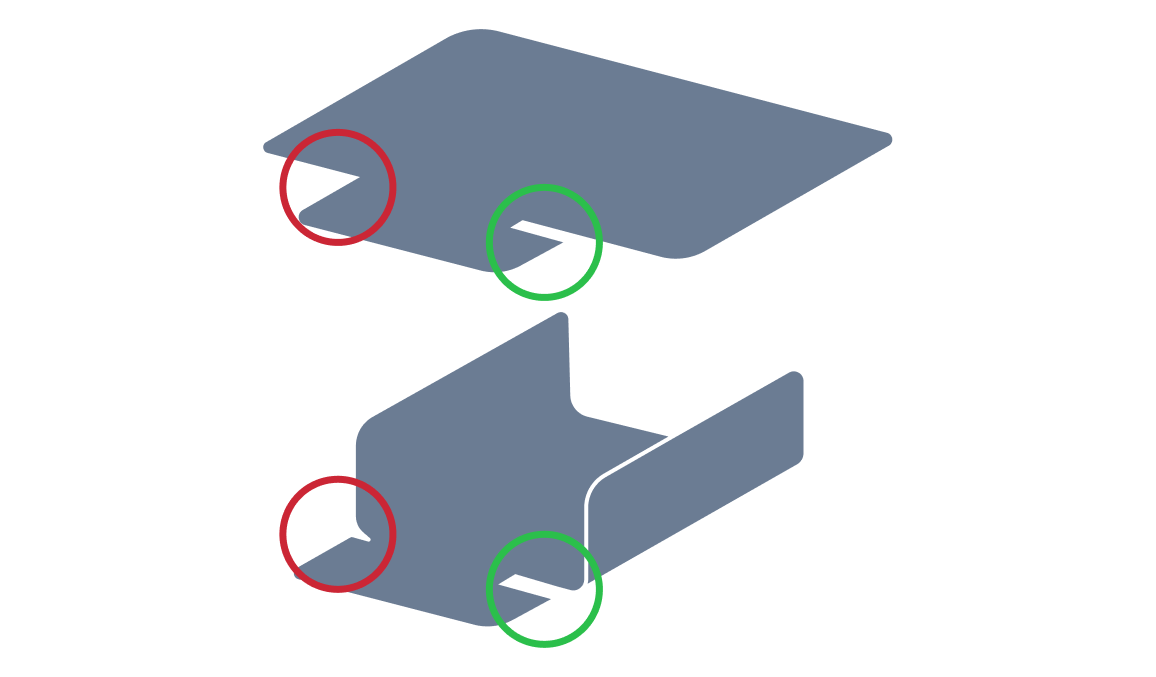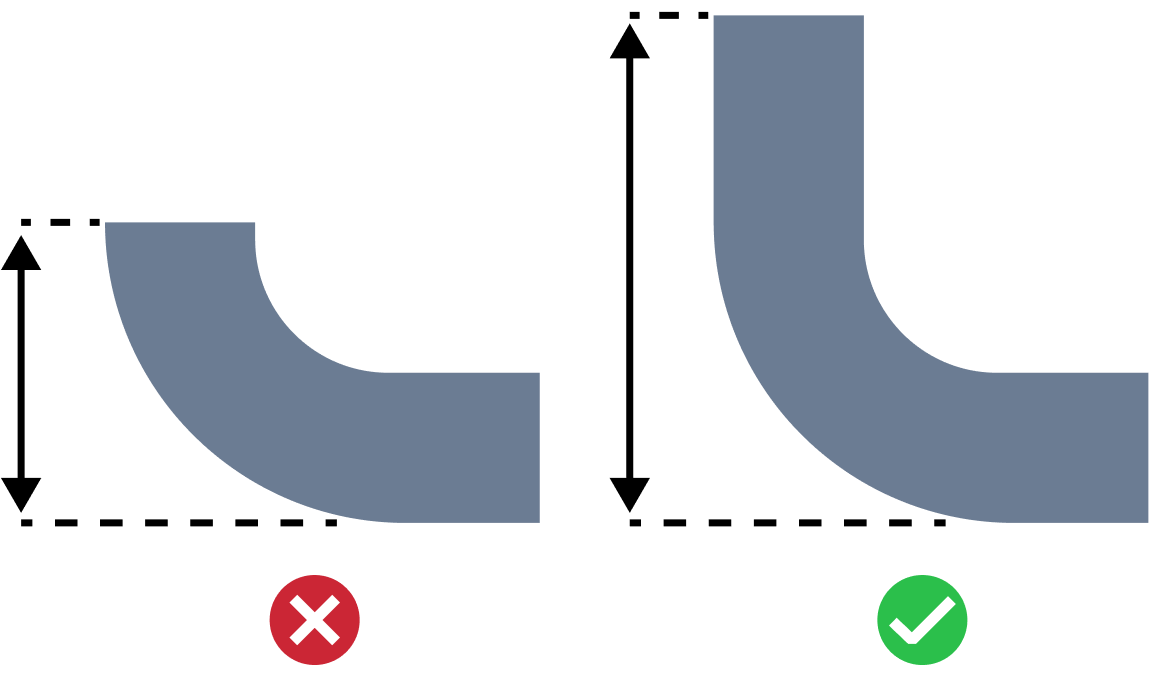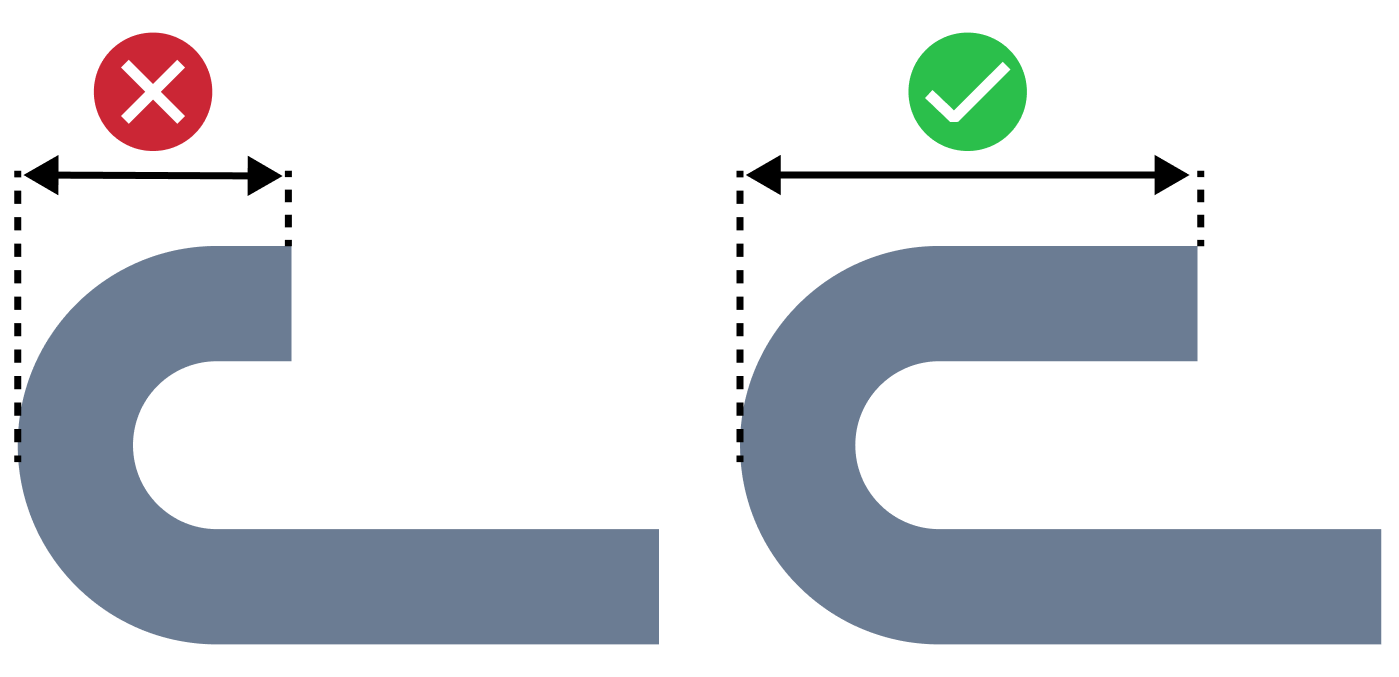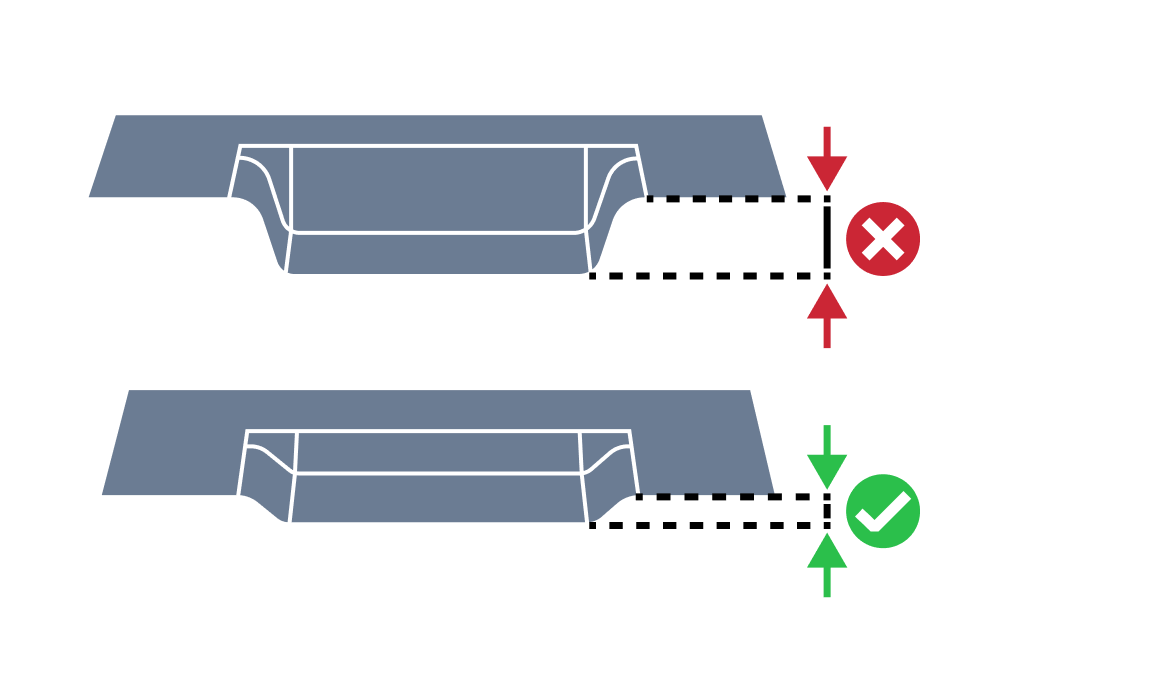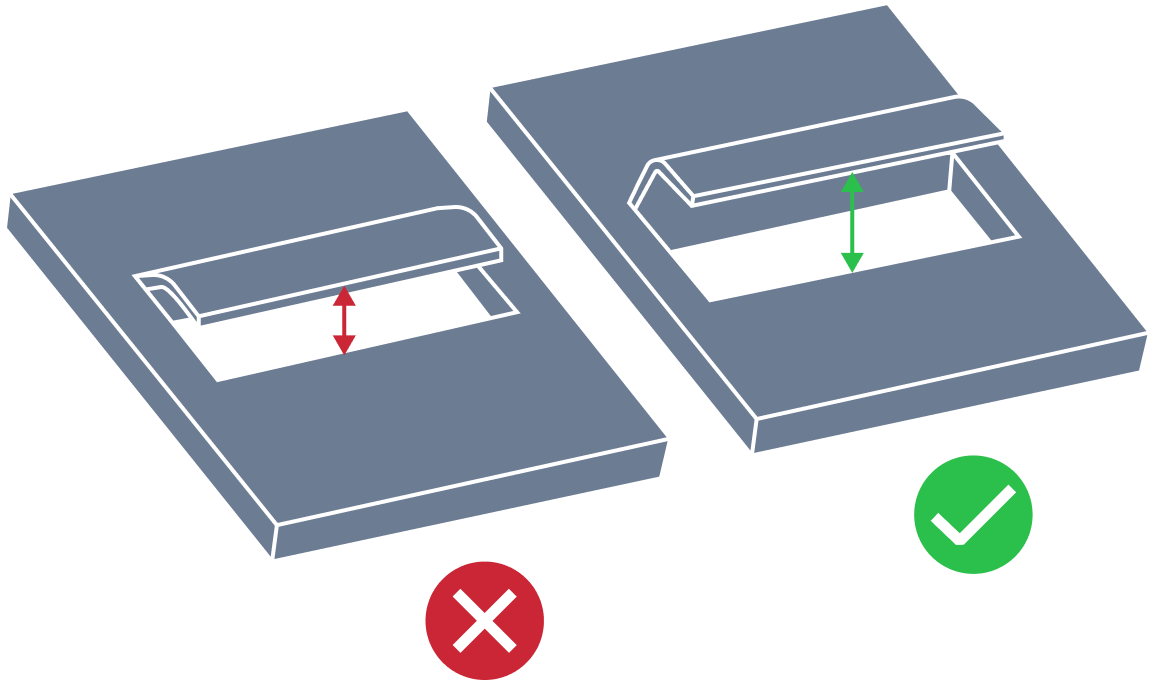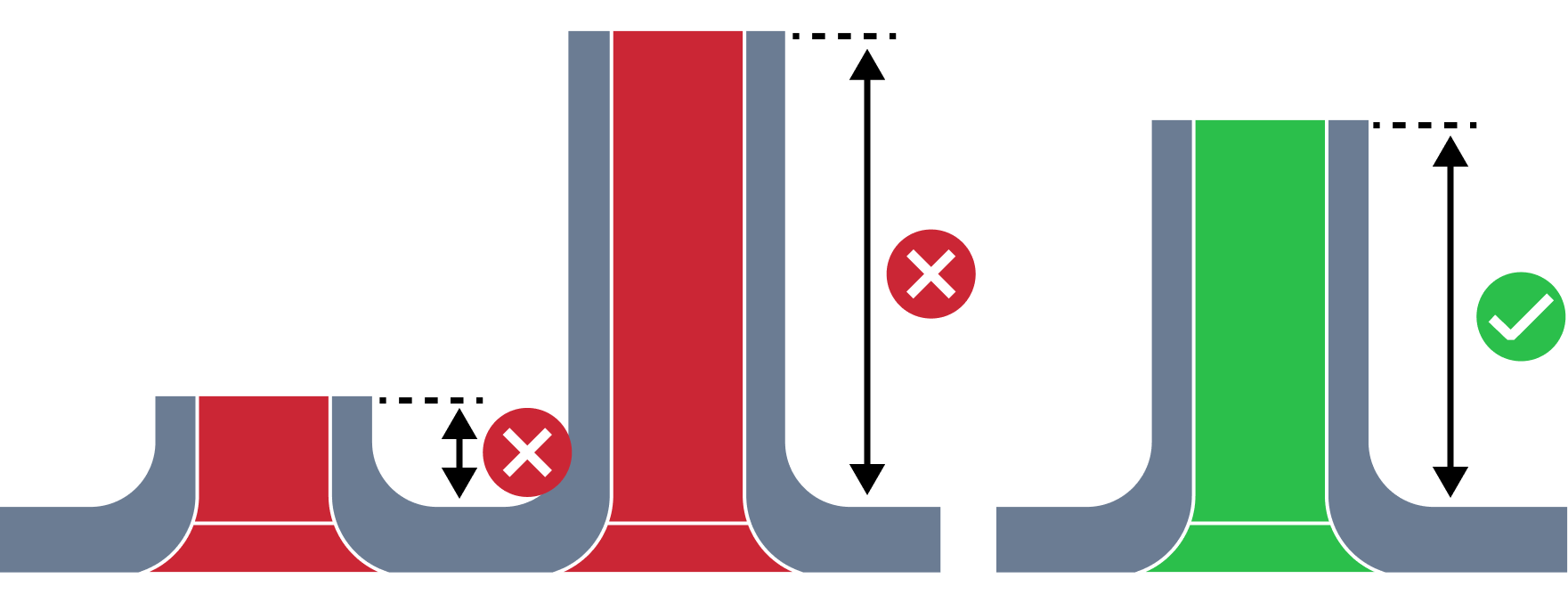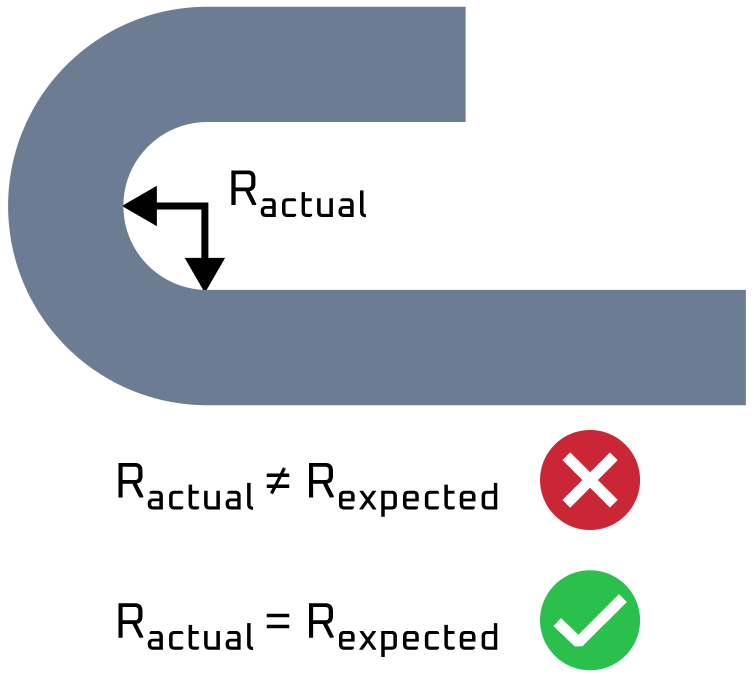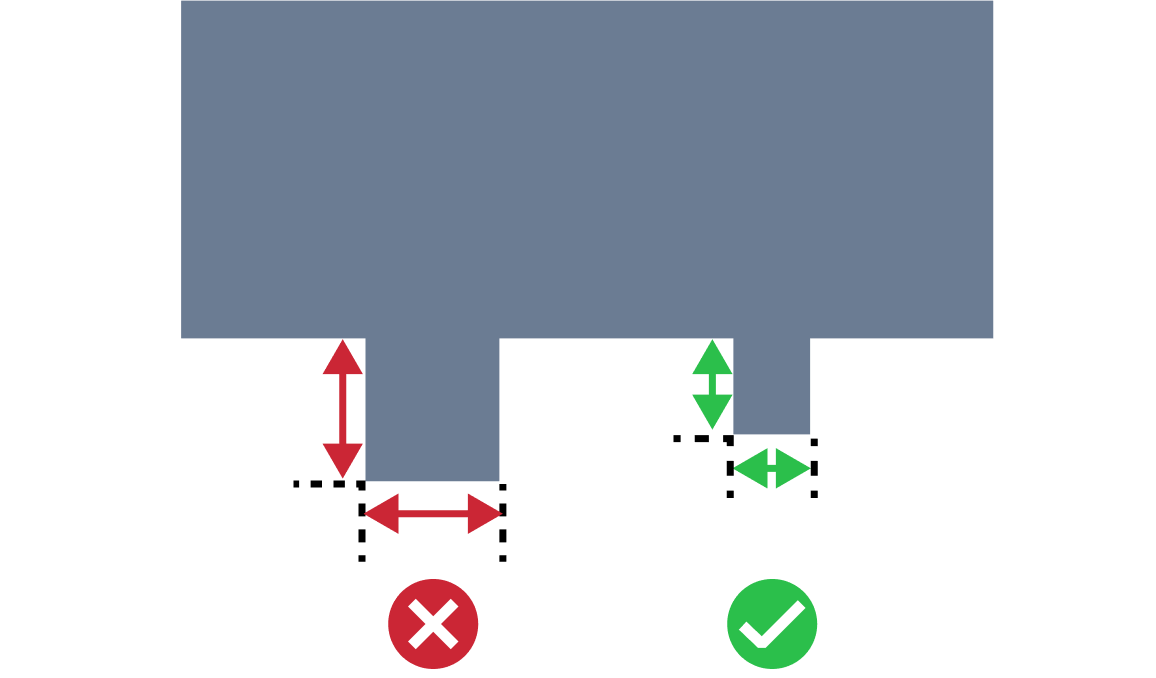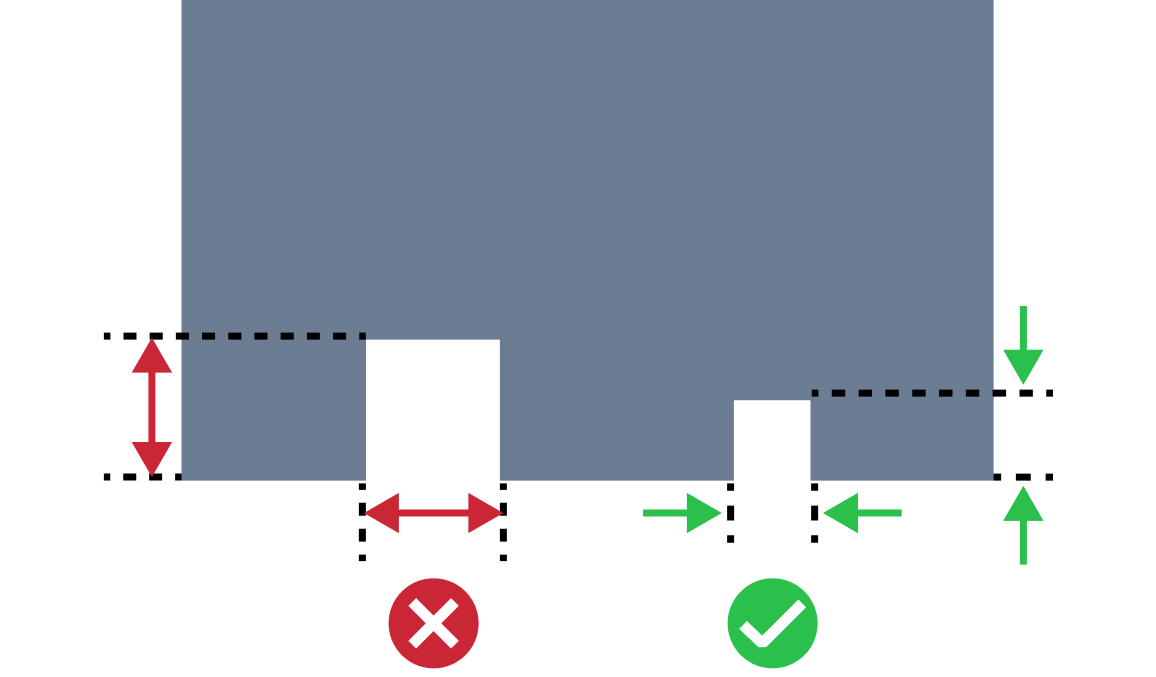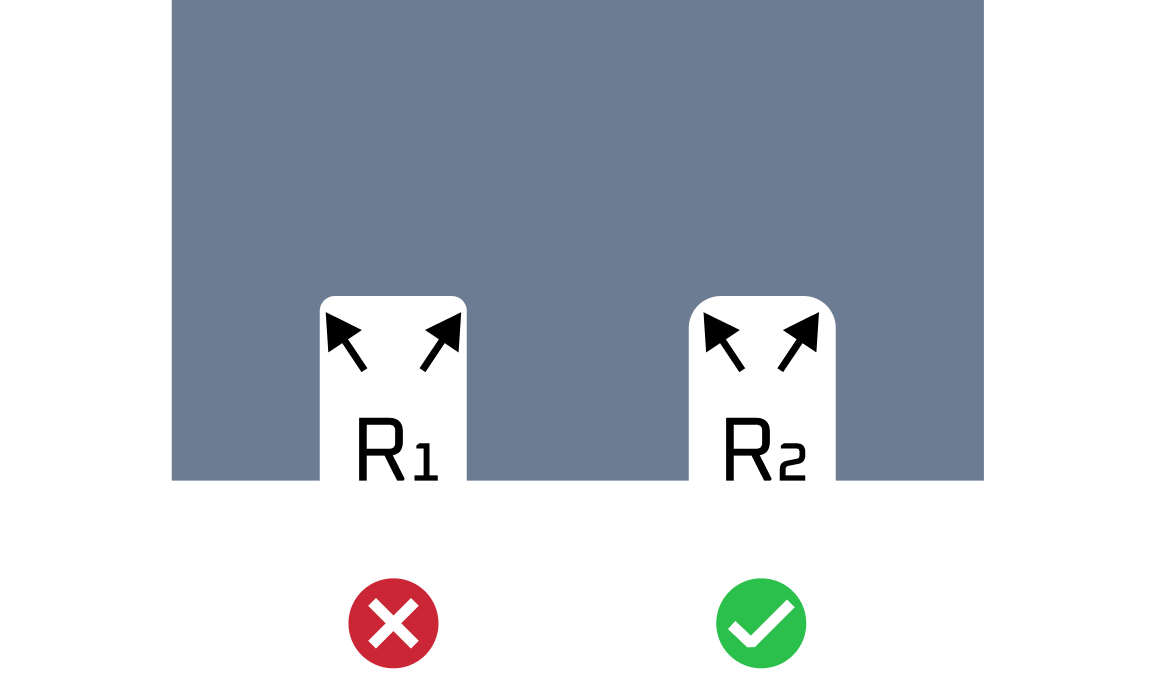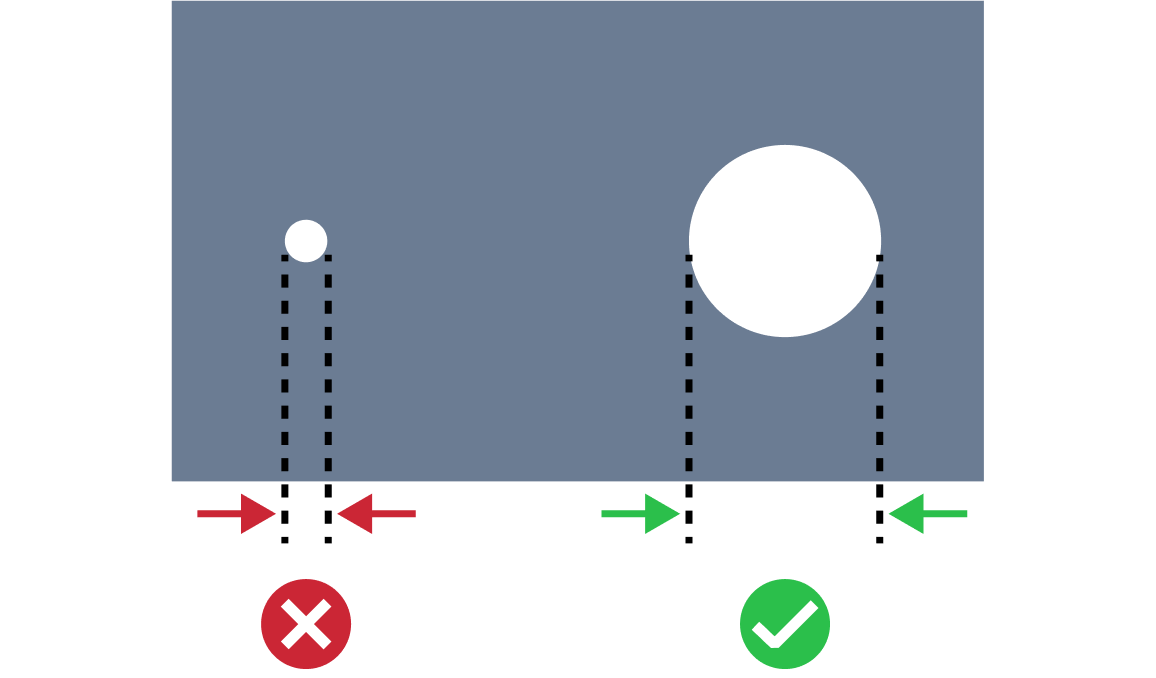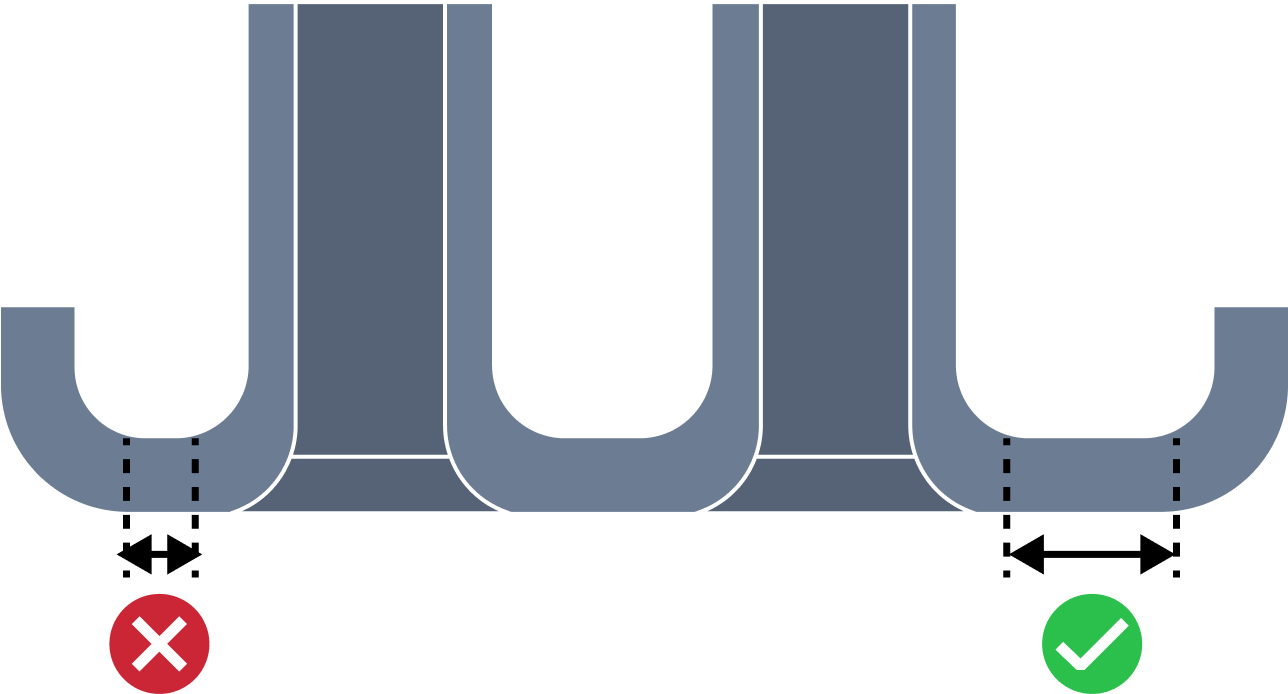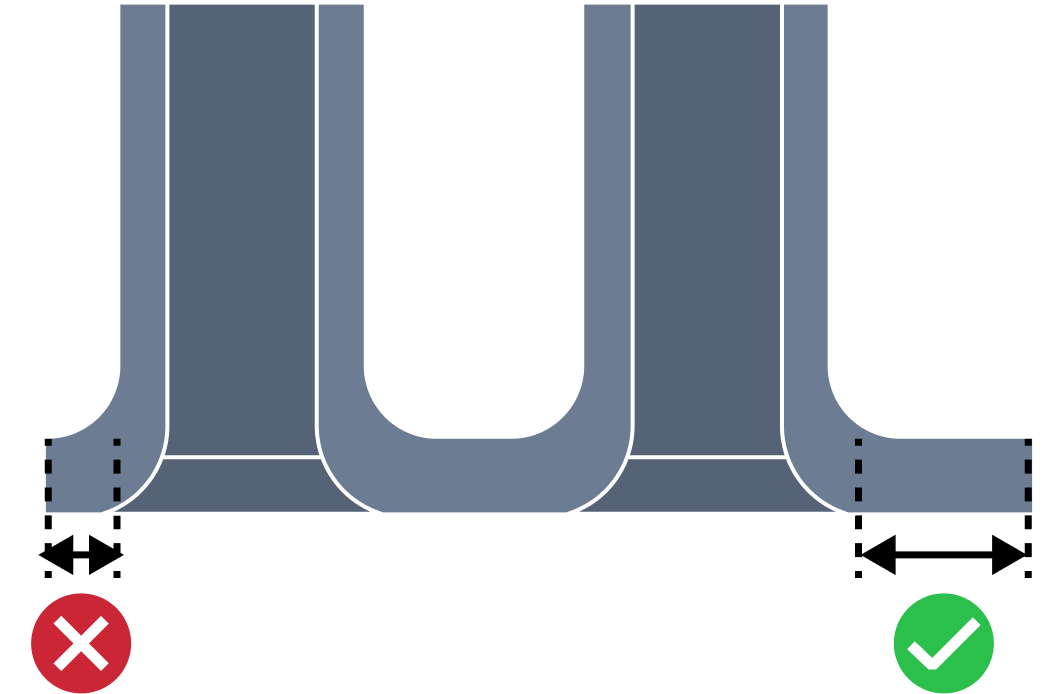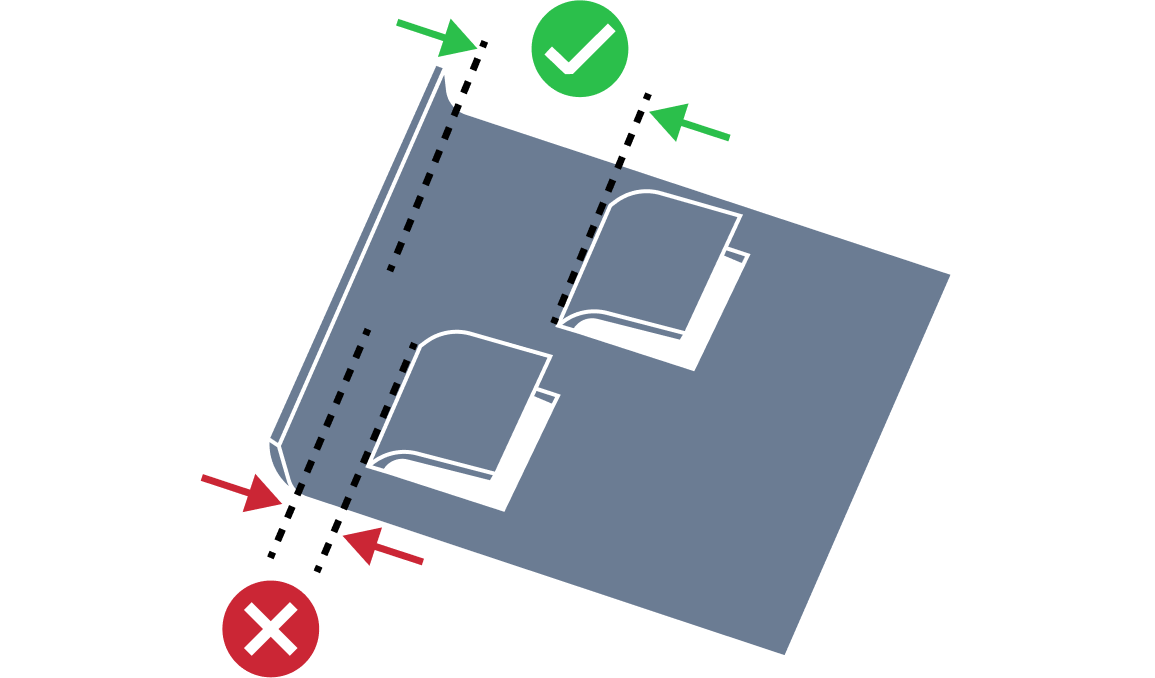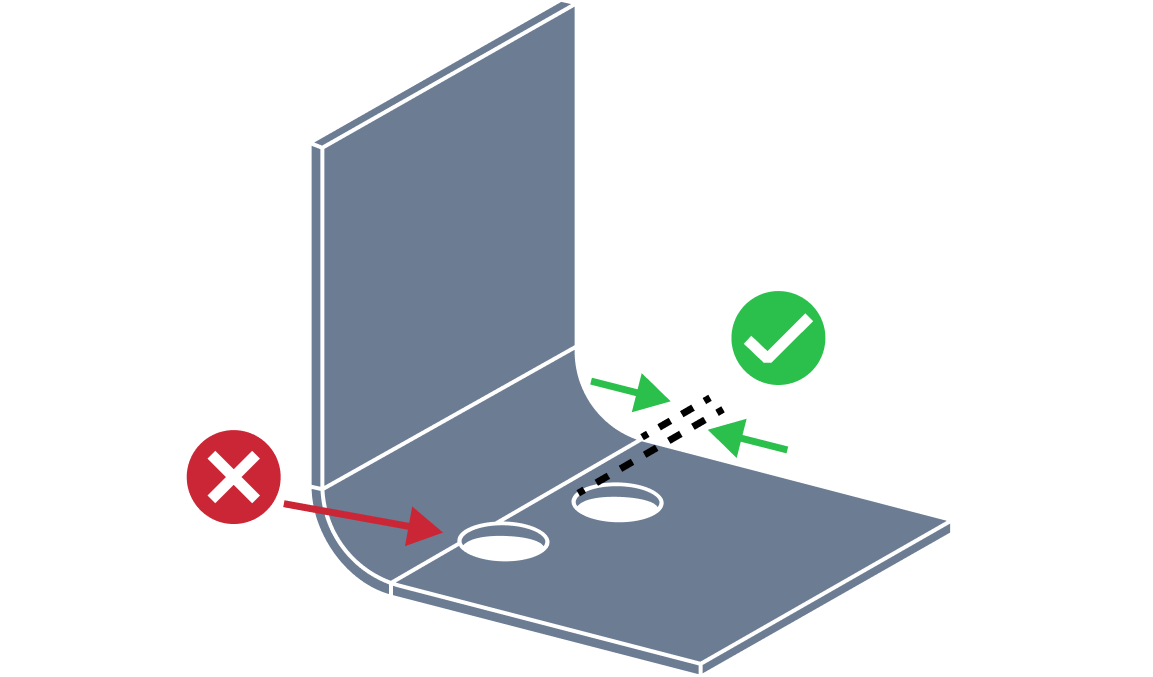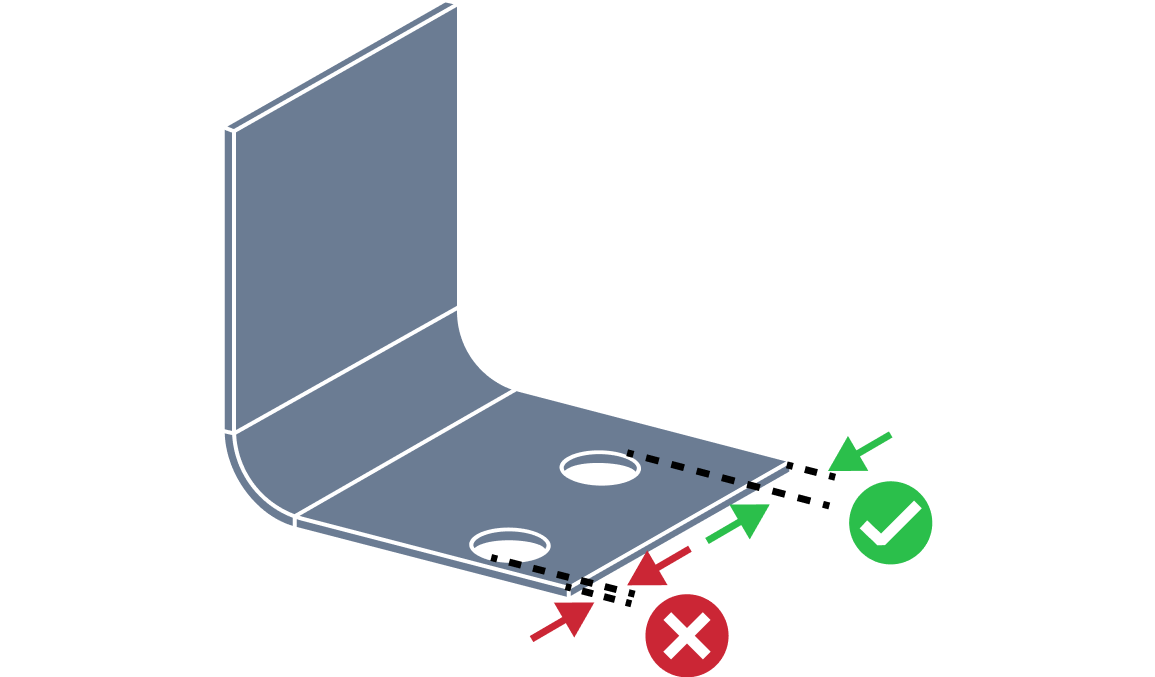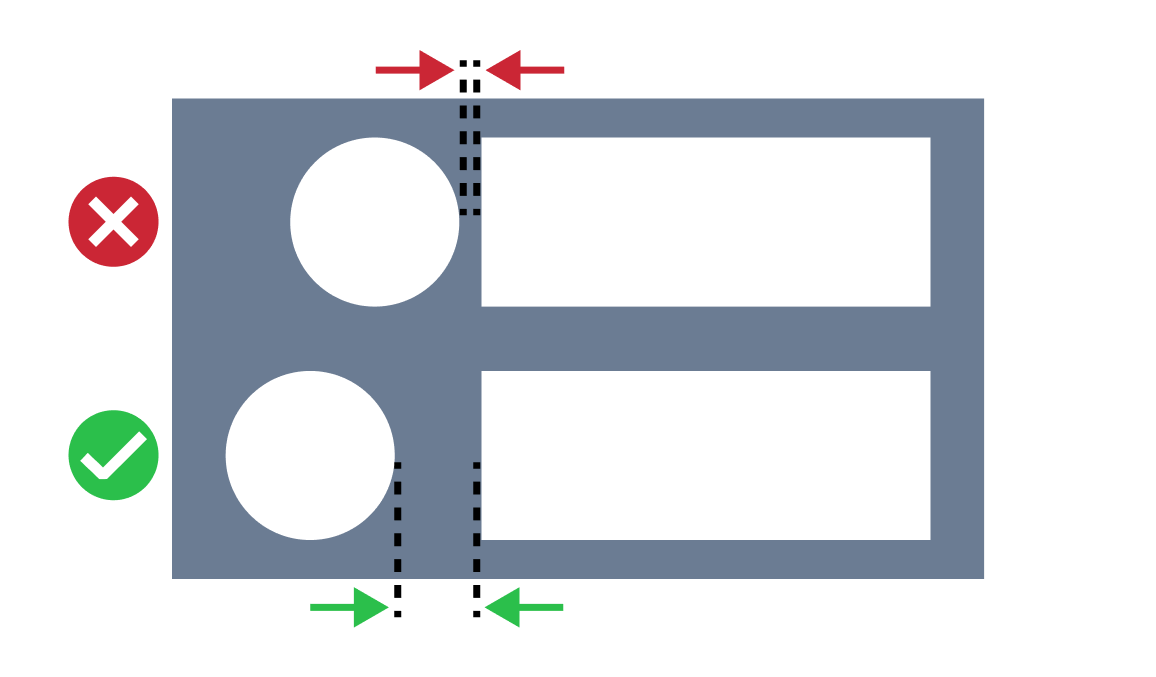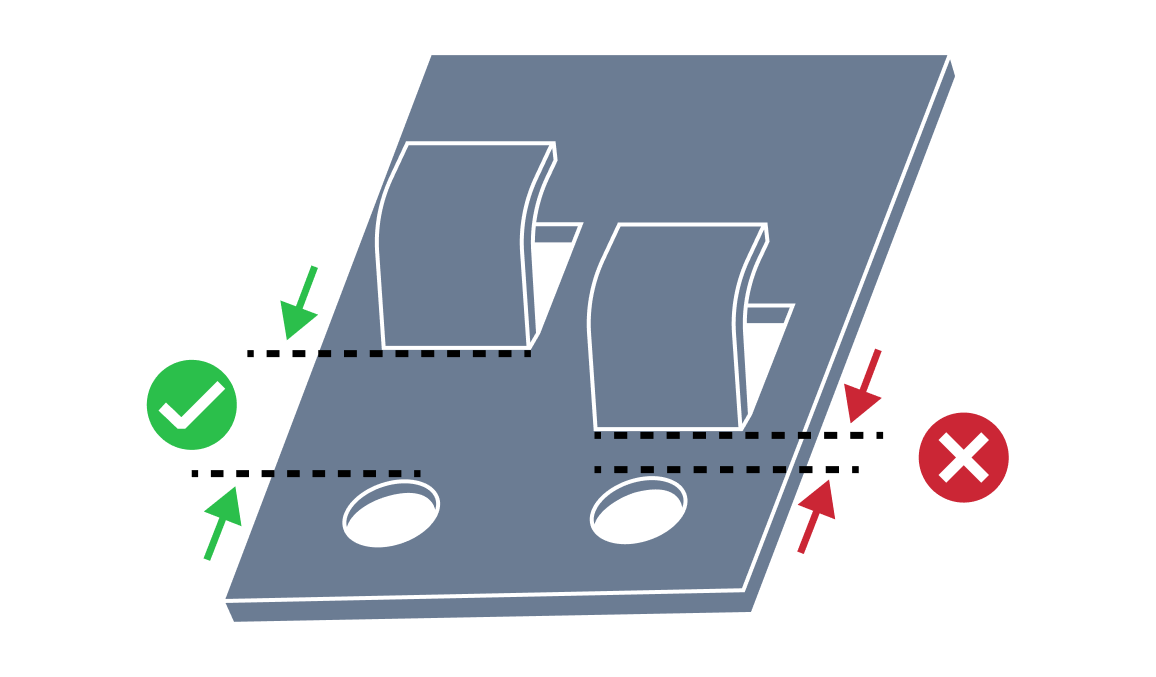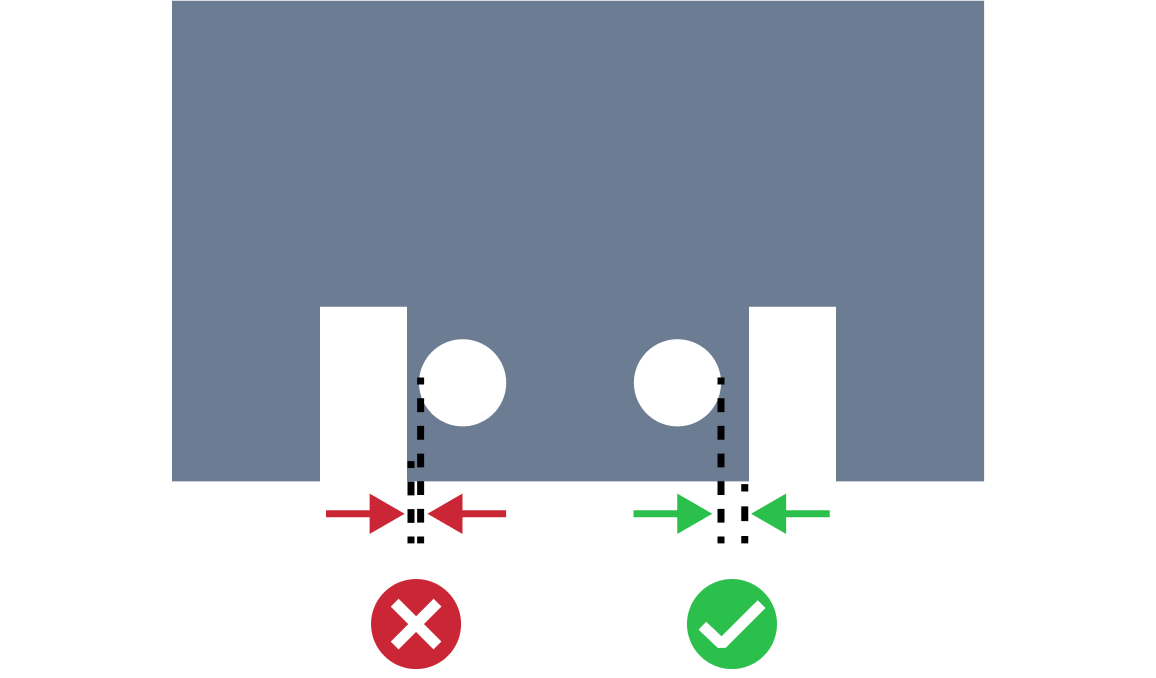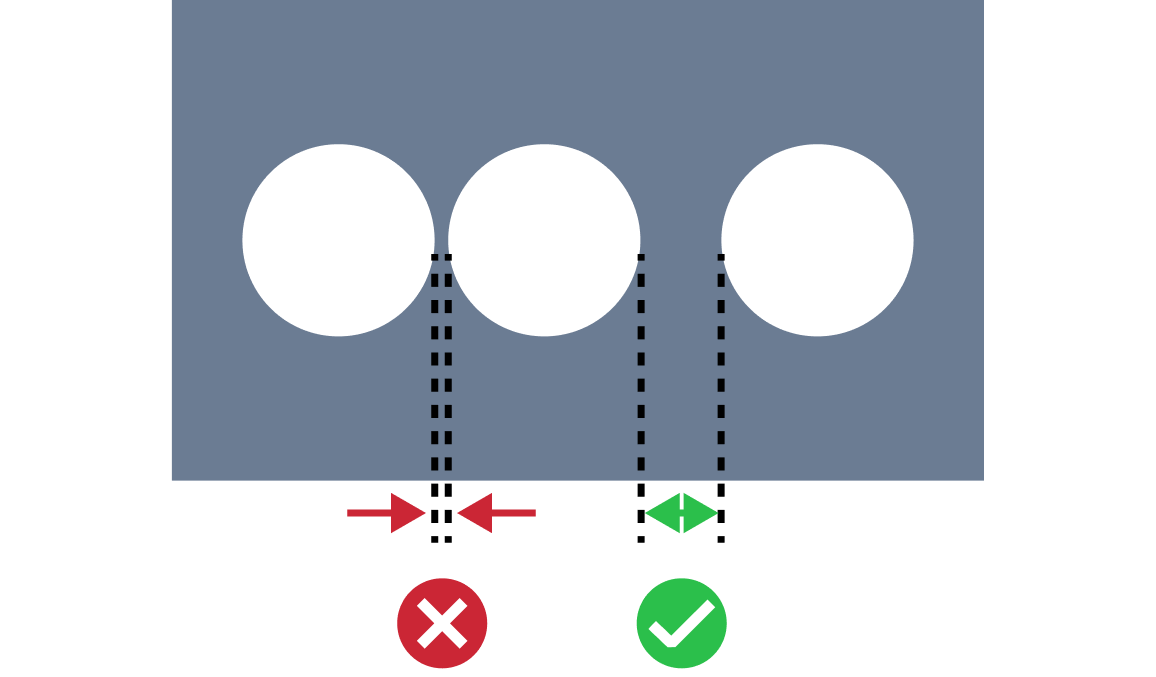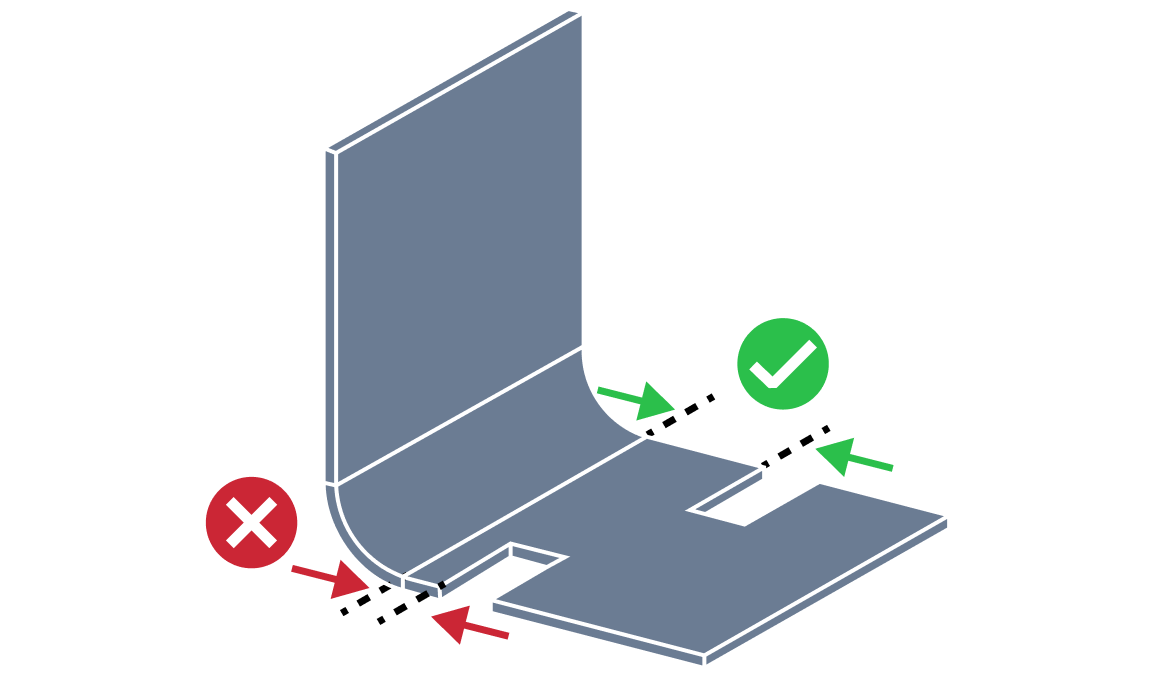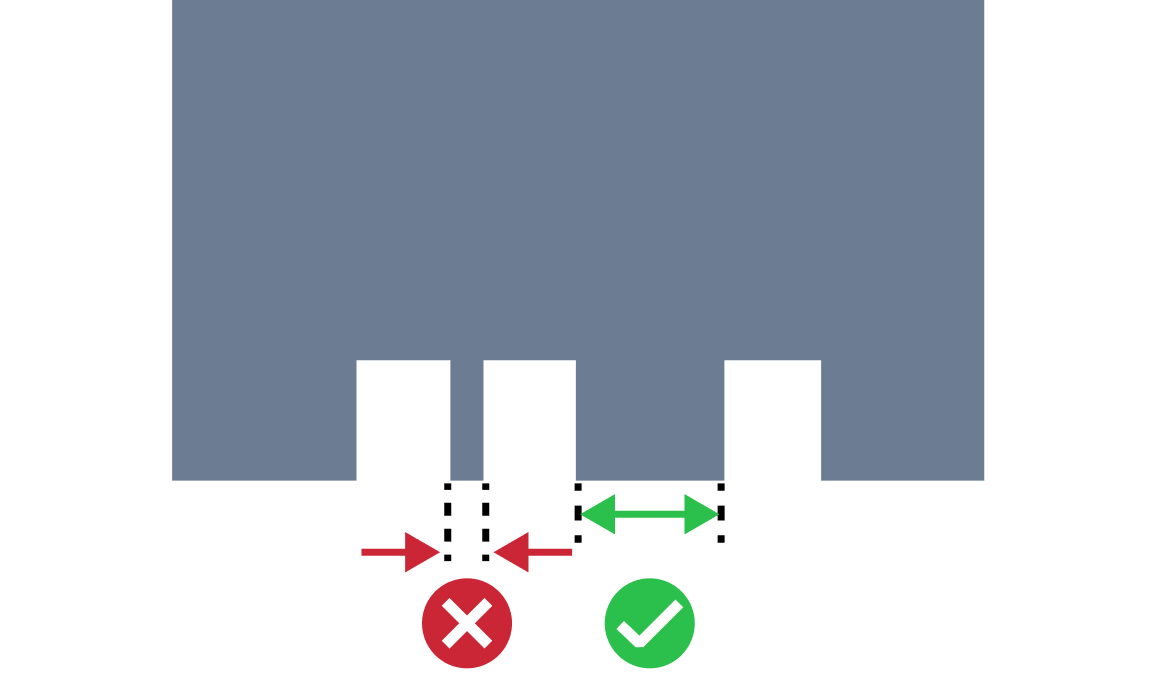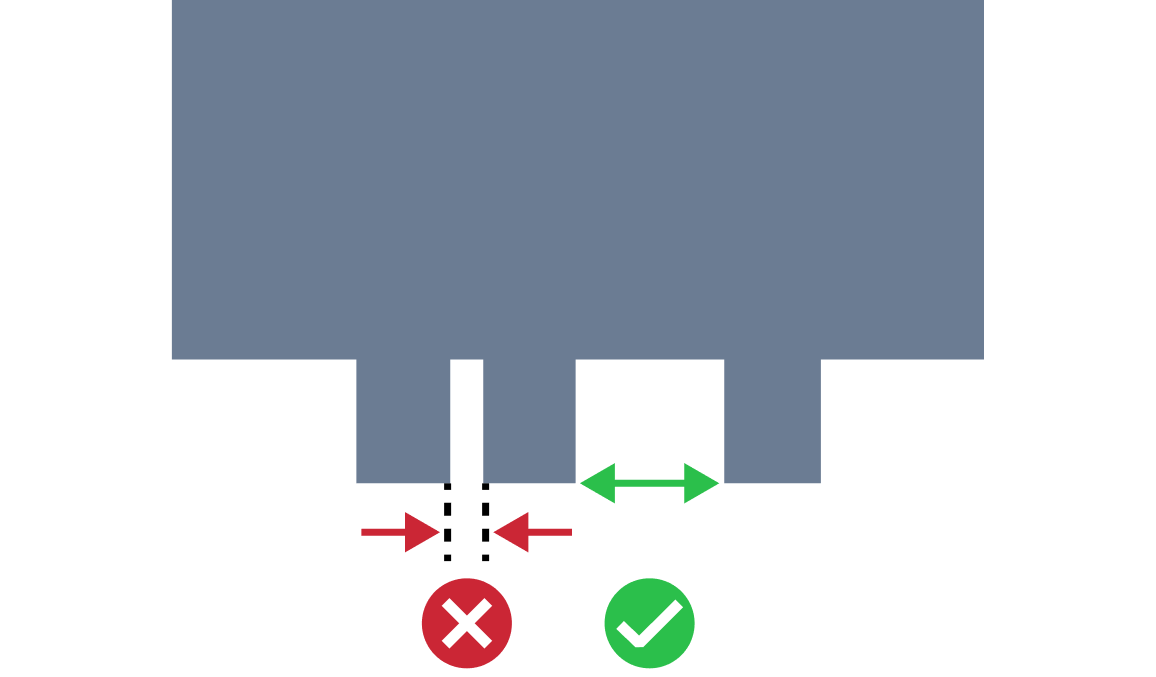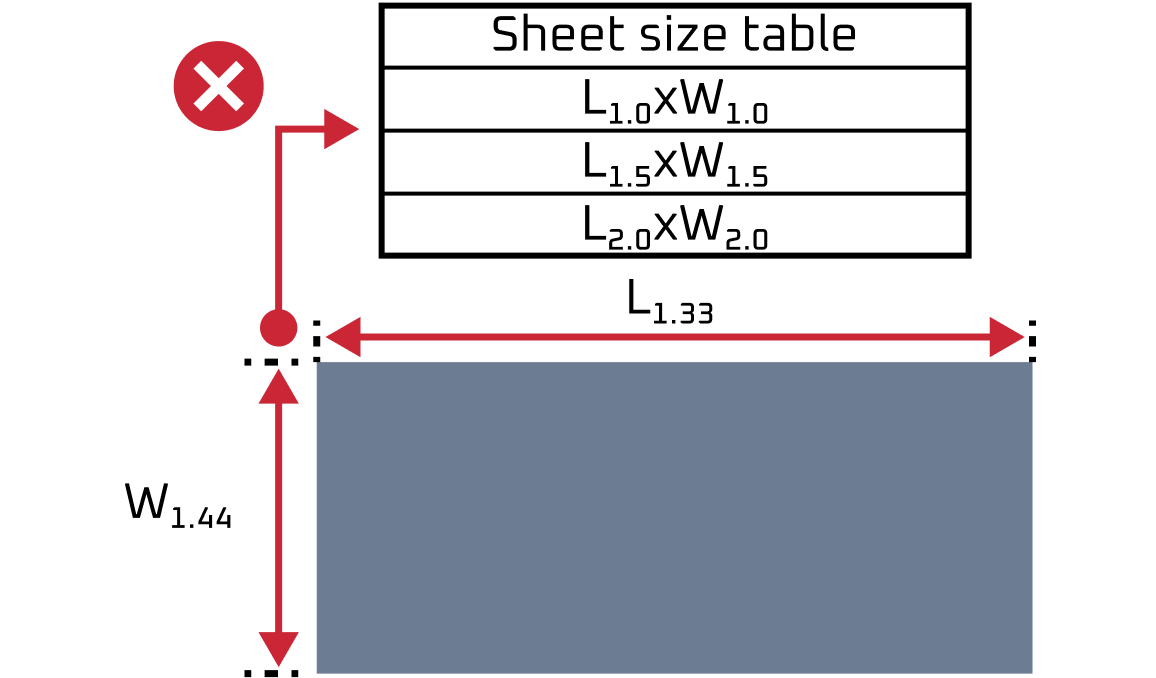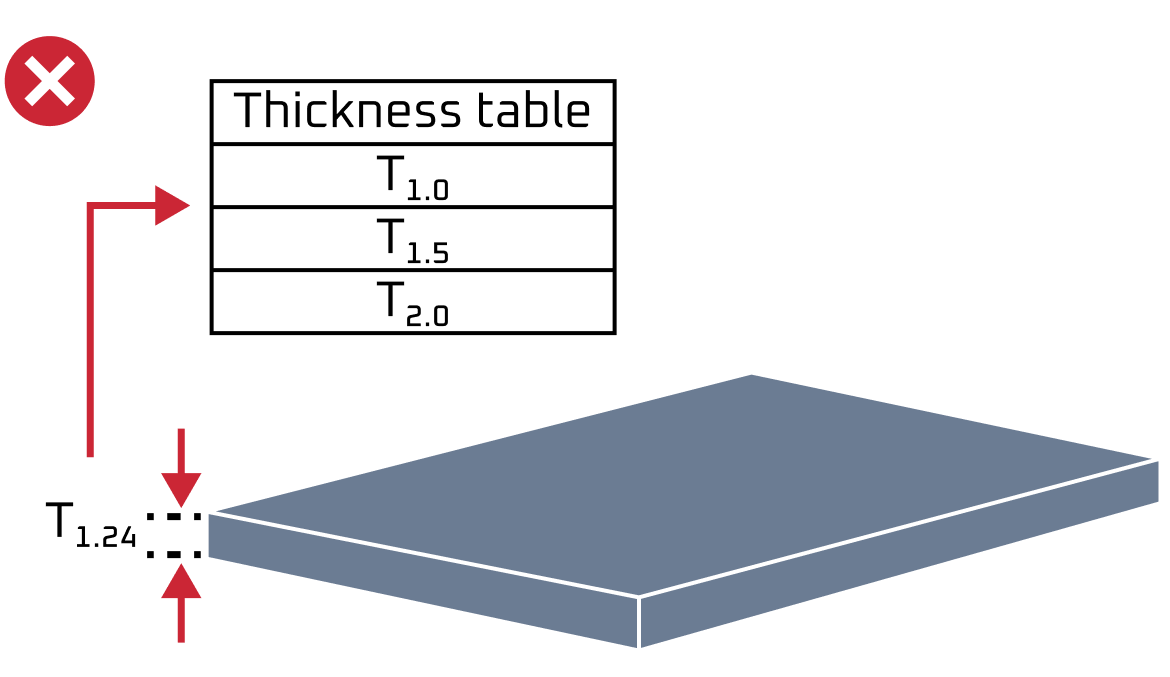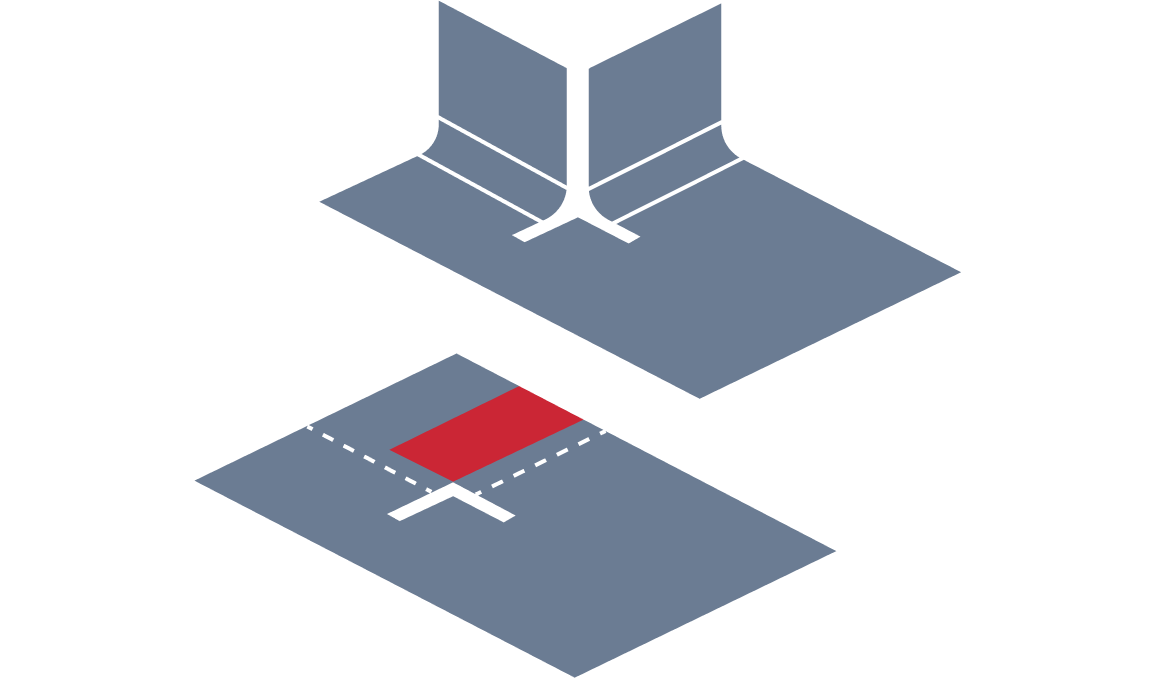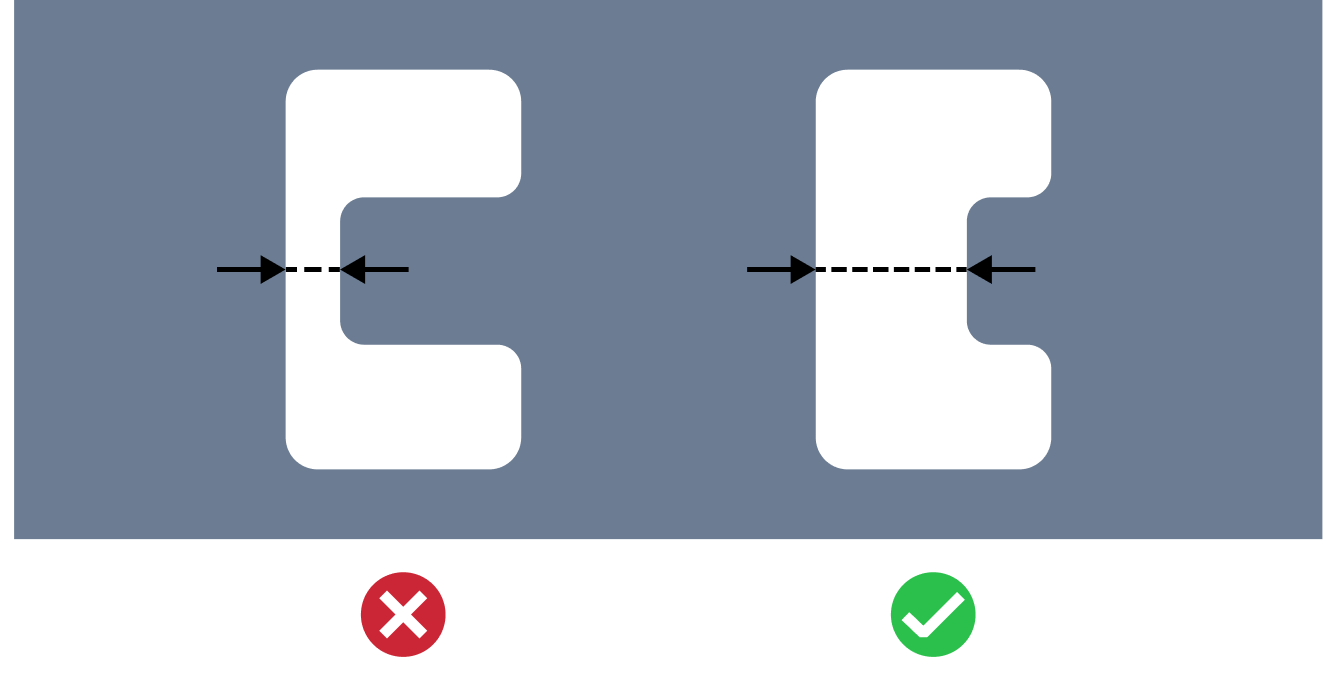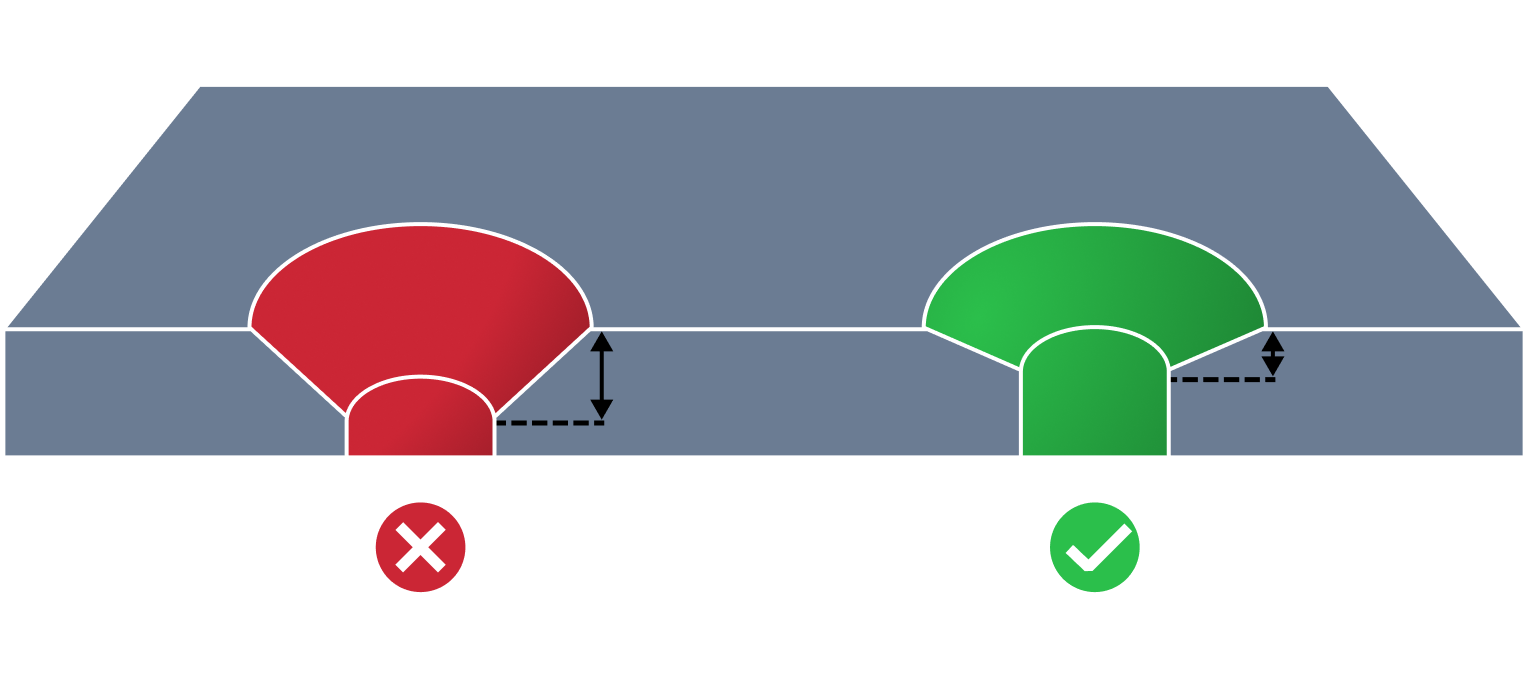| Issue | Description | Example |
| Small Bend Radius | The small bend radius issue refers to a situation where the bend radius is smaller than the recommended one. When the bend radius is too small, the material is stretched too much, which can cause the material to crack or even break. Additionally, a small bend radius can cause the material to distort, resulting in parts that are not as accurate as they should be. |
|
| Inconsistent Bend Radii | This issue occurs when the radius of a bend varies from one section to another, resulting in uneven distribution of stress and strain in the part. Avoiding variety in bend radii help to minimize setup changes during the manufacturing process. When the bend radius is consistent, the machine settings can be standardized, which means that less time will be spent making adjustments between parts. |
|
| Irregular Bend Relief | Irregular bend relief size issue can occur when the bend relief is not proportionally sized to the bend radius and sheet thickness. When the bend relief is too small, it can cause deformation, cracking, or even tearing during the bending process. On the other hand, if the bend relief is too large, it can create weak points in the metal and decrease the overall strength of the design. |
|
| Small Flange Length | The flange length refers to the length of the flat section of a flanged edge. A small flange length issue can occur when the flange length is too small to accommodate the intended bend radius. This can cause the material to wrinkle or crack during the forming process, leading to a defective or unusable part. |
|
| Small Hem Bend Flange Length | The flange length refers to the length of the flat section of a flanged edge. A small flange length issue can occur when the flange length is too small to accommodate the intended bend radius. This can cause the material to wrinkle or crack during the forming process, leading to a defective or unusable part. |
|
| Large Bead Depth | A large bead depth issue can occur when a bead is too deep. This can lead to several problems such as warping, distortion, and even cracking of the material. Additionally, a large bead depth can cause issues with the appearance of the final product. |
|
| Small Louver Depth | Small depth of louvers in sheet metal can lead to limited airflow, reduced strength, clogging or blockage, and increased noise transmission. These factors can impact the effectiveness and efficiency of ventilation systems and the overall durability of the sheet metal structure. |
|
| Irregular Extruded Hole Height | Irregular Depth Extruded Hole issue in sheet metal refers to a problem where the depth of an extruded hole is not consistent or uniform. This issue can bring about a weakened structure, compromised integrity, and difficulties in assembly. |
|
| Irregular Open Hem Bend Radius | The irregular open hem bend radius issue refers to a situation where the bend radius differs from the recommended one. |
|
| Irregular Tab | An irregular tab size issue can arise when the tabs or flanges, that are meant to connect different parts together, have irregular dimensions. This can lead to alignment issues and cause problems during the assembly process. It may also affect the overall strength and stability of the final product. To address this issue, one may need to adjust the dimensions of the tabs or redesign the parts to ensure that they fit together properly. |
|
| Irregular Notch | An irregular notch size issue occurs when the size and shape of the notch is not consistent with the intended design. If a notch size is too large, it might cause parts of the sheet metal to not align properly, or it might create weak points in the metal that could compromise its structural integrity. On the other hand, if the notch size is too small, it can cause the sheet metal to warp or crack during the cutting or bending process. |
|
| Irregular Notch Corner Fillet Radius | If the ratio of the notch corner fillet radius to the thickness of the sheet metal is irregular, this can lead to problems in the production of notches. Straight corners of the notch can be difficult to shear cleanly without causing deformation or fractures in the material. Rounded corners help distribute cutting force more evenly, reducing the chance of warping or breaking and providing a cleaner, more precise cut. |
|
| Small Hole Diameter | Small hole diameter issue refers to the problem where holes with a diameter of less than required may cause deformation or cracking of the metal. This happens because the force required to create the hole exceeds the yield strength of the material, causing it to buckle or distort. |
|
| Small Distance Between Extruded Hole And Bend | When a hole is punched too close to the edge of a bend, it can create stress concentration in the metal around the hole. This can weaken the sheet metal part and may even cause it to fail. |
|
| Small Distance Between Extruded Hole And Edge | When a hole is punched too close to the edge of a sheet metal part, it can create stress concentration in the metal around the hole. The stress concentration is caused by the abrupt change in geometry at the edge of the hole, which can cause the metal to deform, crack, or even fail. This can be especially problematic in parts that will experience high loads or stress, as it can compromise the integrity of the part and its ability to perform its intended function. |
|
| Small Distance Between Extruded Holes | When designing sheet metal parts with multiple extruded holes, it is important to consider the spacing between those holes. If the distance between the holes is small, the material between them will become thinner, which can cause the sheet metal part to become weaker and potentially break under stress. This is because the stress applied to the sheet metal part is not distributed evenly throughout the part, and the material between the holes is not strong enough to handle the load. |
|
| Small Distance Between Bend And Louver | When the distance between these two features is too small, it can lead to a number of issues during the manufacturing process. Firstly, it can lead to collision or contact, which may result in damage to the louver, the sheet metal, or both. This can also cause problems during the bending process, as the louver may get trapped or deformed in the bend, affecting the overall quality and functionality of the final product. Furthermore, it can hinder the airflow, reducing the efficiency of the ventilation system, because louvers are typically used to allow for air circulation or to serve as an intake or exhaust system. |
|
| Small Distance Between Hole And Bend | When a hole is drilled too close to the edge of a bend, it can create stress concentration in the metal around the hole. During the bending process, the metal around the hole may stretch or compress in a way that causes it to deform or tear. This can weaken the sheet metal part and may even cause it to fail. |
|
| Small Distance Between Hole And Edge | When a hole is drilled too close to the edge of a sheet metal part, it can create stress concentration in the metal around the hole. The stress concentration is caused by the abrupt change in geometry at the edge of the hole, which can cause the metal to deform, crack, or even fail. This can be especially problematic in parts that will experience high loads or stress, as it can compromise the integrity of the part and its ability to perform its intended function. |
|
| Small Distance Between Hole And Cutout | When a hole is drilled too close to the edge of a bend, it can result in a weakened area, making the sheet metal more prone to cracking or breaking. This can be especially problematic if the sheet metal is intended to support weight or pressure in its final use. |
|
| Small Distance Between Hole And Louver | When a hole is drilled too close to the edge of a louver, it can cause manufacturing difficulties, compromise structural integrity, restrict airflow, and result in aesthetic concerns. |
|
| Small Distance Between Hole And Notch | When a hole and notch are placed too close together, it can cause the surrounding metal to weaken and potentially crack, leading to structural issues or failure. This is particularly important in applications where the sheet metal will be subjected to high levels of stress or strain, such as in load-bearing structures or in parts that will be exposed to vibration or other types of mechanical stress. |
|
| Small Distance Between Holes | When designing sheet metal parts with multiple holes, it is important to consider the spacing between those holes. If the distance between the holes is small, the material between them will become thinner, which can cause the sheet metal part to become weaker and potentially break under stress. This is because the stress applied to the sheet metal part is not distributed evenly throughout the part, and the material between the holes is not strong enough to handle the load. |
|
| Small Distance Between Notch And Bend | When the distance between these two features is too small, it can lead to a number of issues during the manufacturing process. For example, when a sheet metal component is bent, the metal is stretched and compressed, which can cause it to deform or even crack. If there is a notch too close to the bend, it can create a stress concentration point that can exacerbate this problem. |
|
| Small Distance Between Notches | When the notches are placed too close together, it can weaken the overall structure of the sheet metal. This is because the material between the notches is relatively thin and therefore more susceptible to bending or breaking. |
|
| Small Distance Between Tabs | When the tabs are too close together, they may interfere with each other and prevent the parts from properly fitting together. Additionally, if there is not enough clearance between the tabs, it may be difficult or impossible to bend or form the metal during fabrication. This can cause manufacturing delays or may even require design changes to be made. |
|
| Non Standard Sheet Size | The non-standard flat pattern sheet size issue refers to situations where the flat pattern sheet size required for a particular design is not readily available from standard sheet sizes. This can be a problem because the non-standard sheet size may be more expensive or harder to find than the standard sizes. |
|
| Non Standard Sheet Thickness | The non-standard sheet thickness issue refers to the use of sheet metal that is not available in standard thicknesses. This can be a problem because it can make the fabrication process more difficult and add additional costs. Typically, sheet metal is available in a range of standard thicknesses, which makes it easier to design and fabricate parts. However, when a non-standard thickness is required, it can create issues with tooling, bending, and other fabrication processes. |
|
| Flat Pattern Interference | Flat pattern interference occurs when the flattened shape of a part does not fit properly on the flat sheet material that it is cut from. This can result in issues during the manufacturing process, such as warping or bending of the material, or inaccuracy in the final product. |
|
| Narrow Cutout | Narrow cutout issue refers to the problem where cutouts with a width smaller than required may cause incomplete cutting, slag accumulation, or dimensional inaccuracy. This happens because the laser beam cannot reliably clear material in narrow sections, leading to unstable cutting, burn-through, or poor fit of mating parts. |
|
| Large Depth Countersink | Large depth countersink issue occurs when the countersink is too deep for the sheet thickness, causing material displacement and a bulge on the opposite face. This deformation can lead to poor surface quality, misalignment during assembly, and potential weakening of the sheet around the hole. |
|
